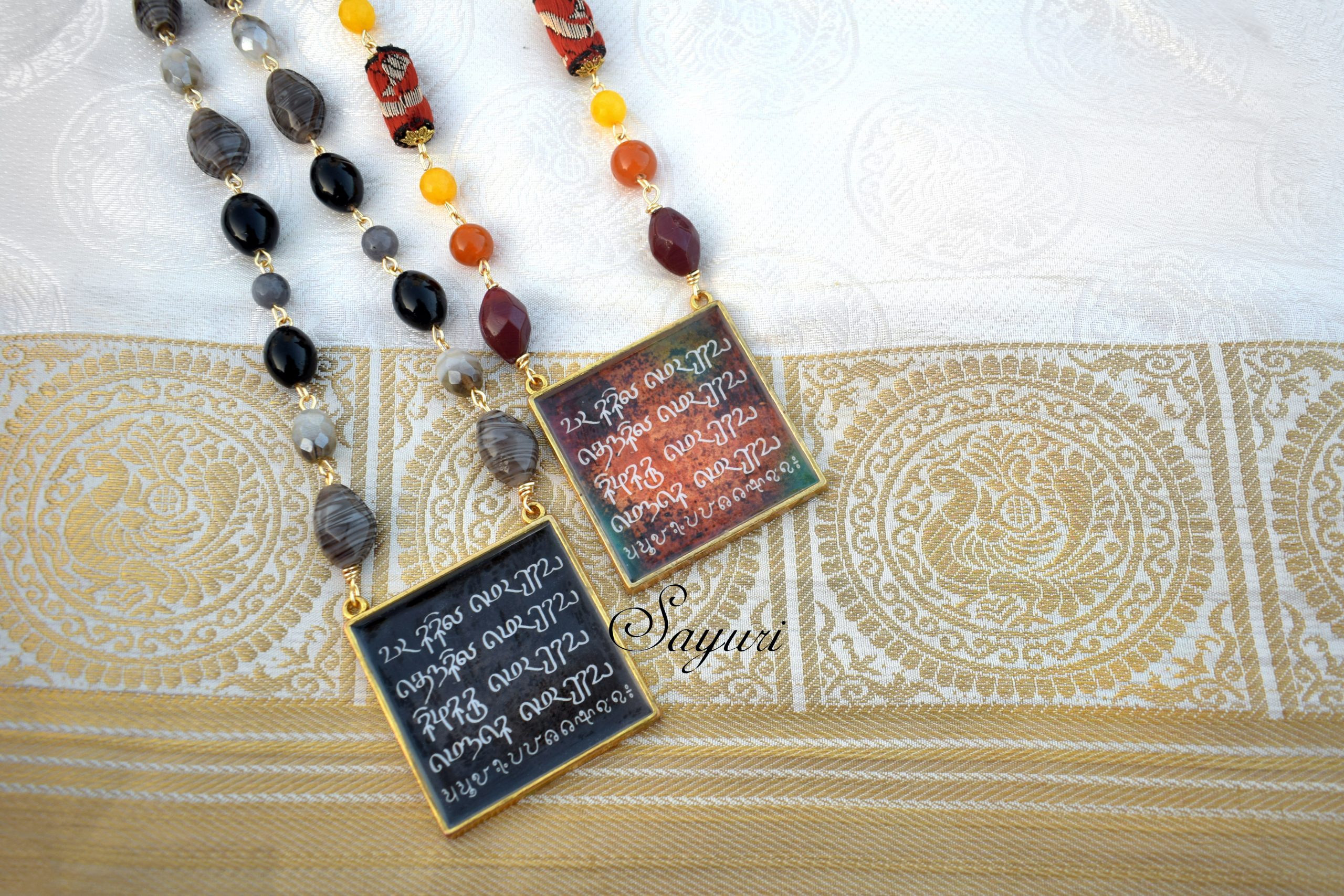In continuation to my post on Tamil Jewellery, where I described the Tamil Logo jewellery that I created, here is a post on jewellery based on a Tamil Script. Even before I started to teach communication design I had an inkling towards typographical prints. Though I have made several text based prints for apparel, I never created a script based print for jewellery before. Recently, I came across Adhiyaman Ilangovan’s Vattelgraphy page on Instagram and got hooked on to the Vatteluthu typography. Therefore, I researched about the script and taught myself to write it on Adobe illustrator. Letters soon became words and thus were born the Tamil Vatteluthu necklaces that you see in the Marabu collection.
Why use a script? It is easier to incorporate the visual entity such as a script of a language than the sounds or grammar in jewellery.

Tamil Vatteluthu
Vatteluthu is a Tamil script which translates to curved/rounded letters or chiseled letters. Pronounced as Vattezhuthuthu it was used to write the Proto Tamil language anywhere between 1st Century AD uptil 9th century AD. There is varying information about its origin and the time period it was in use. The general consensus is that the script must have been adapted from Tamil Brahmi or Tamili script (dated around 3rd BCE) to make it suitable to writing on palm leaf. Vatteluthu was also used to write Malayalam, another south Indian language.

While I cannot talk about the script suitability for use on Palm leaf earnestly, I can safely say that this is a script for the digital world. The letters and words that you see in the pieces were written by me using a mouse-paint brush/pen tool in Adobe illustrator. It was very easy to write/paint unlike modern scripts for which you need the type tool.

Vatteluthu Palm leaf style necklace
The first piece that I want to show is a Vatteluthu Palm leaf style necklace with wood, fabric and glass beads. I made a stone edict version of it which flopped at the resin stage. However, I’ll give it another try soon. While writing this post, I came across an app Jinavani which converts modern Tamil to Vatteluthu. It may be interesting to look into it.

Here is what is written in the necklace in palm leaf style. Rows 1,6 and 7 belong to an earlier form of the script and the the other rows are in a style followed by Adhiyaman. Madras is a the Colonial name for Chennai.
Row 1 – Vatteluthu
Row 2 -Merkke Madras – To the west, is Madras
Vadakkil Madras – In the north, is Madras
Row 3 – Therkkil Madras – In the south, is Madras
Kilakke Madras – To the east, is Madras.
Rows 6-7 – Vowels and Consonants of Tamil Vatteluthu
Rows 4-5 are a repeat of rows 2 and 3. This is a way of mapping geographical boundaries in the past. Typically, the land will be bordered by other countries. But I was trying to imply that the city Madras – now Chennai has grown so vast that it extends in all four directions. It also means that Madras surrounds me on all four directions.

Tamil Vatteluthu necklaces
To keep up with orders for the Tamil Vatteluthu necklace, I made three variations. The origins of Vatteluthu was traced from stone edicts with epigraphy. Also, in ancient times engraving or embossing on copper plates were a popular way to document important messages. With that in mind, I designed two variations – one stone and other copper plate Tamil Vatteluthu necklaces. The copper one is sold but can be made again on order.

When I say stone, I don’t mean that the necklace made up of actual granite. The print background texture resembles that of a granite stone used in Temple construction in South India. I have used resin to set all the prints in their respective bezels. The glass beads and bigger bezels make it slightly heavy but it’s not stone heavy to answer a question I got on instagram.

The square gray stone version and the one with the round pendant that you see above are available for sale. I have used glass and agate beads in all the pieces, which fabric beads I am also working on another Palm leaf style piece that may be up for sale soon. Look out on my Instagram/Facebook handles for it.
I truly enjoyed writing an ancient script, imagining myself as a ancient documenter, charting out border territories. It was tough initially, to work on Illustrator and then structuring the text. However, the benefits of creations variations far outweigh the effort. What do you think about this experiment? What more can I do with textual scripts? Please tell me in the comments.
I hope you found it interesting
Cheers



What do you think?